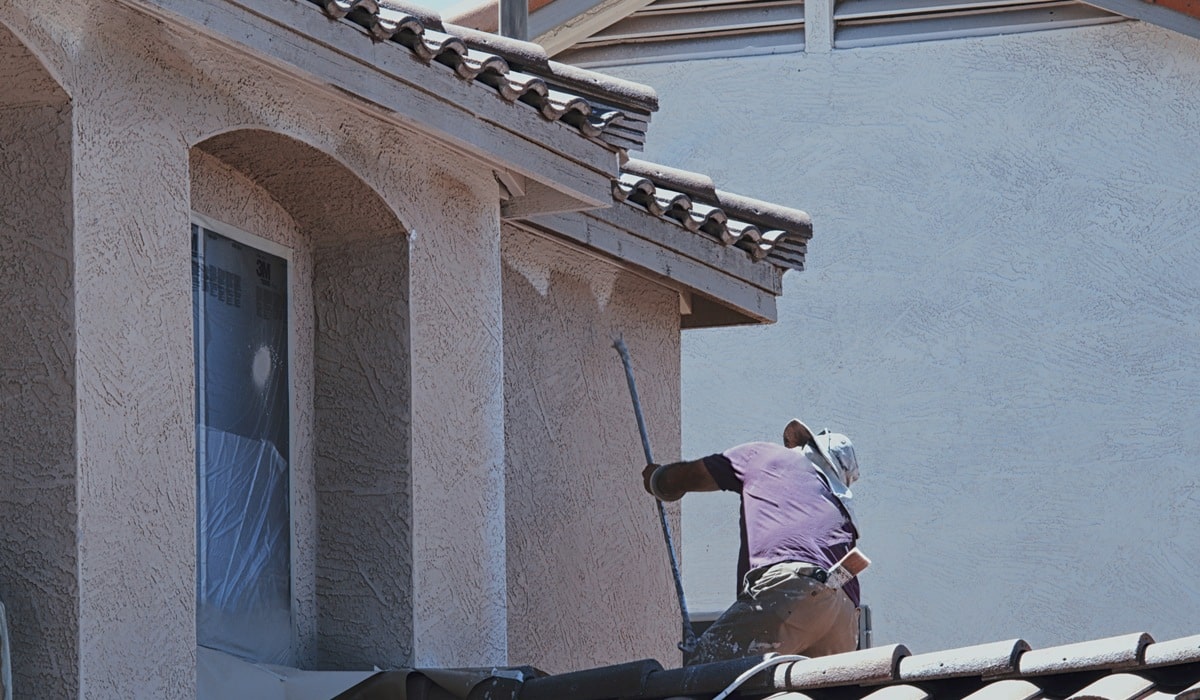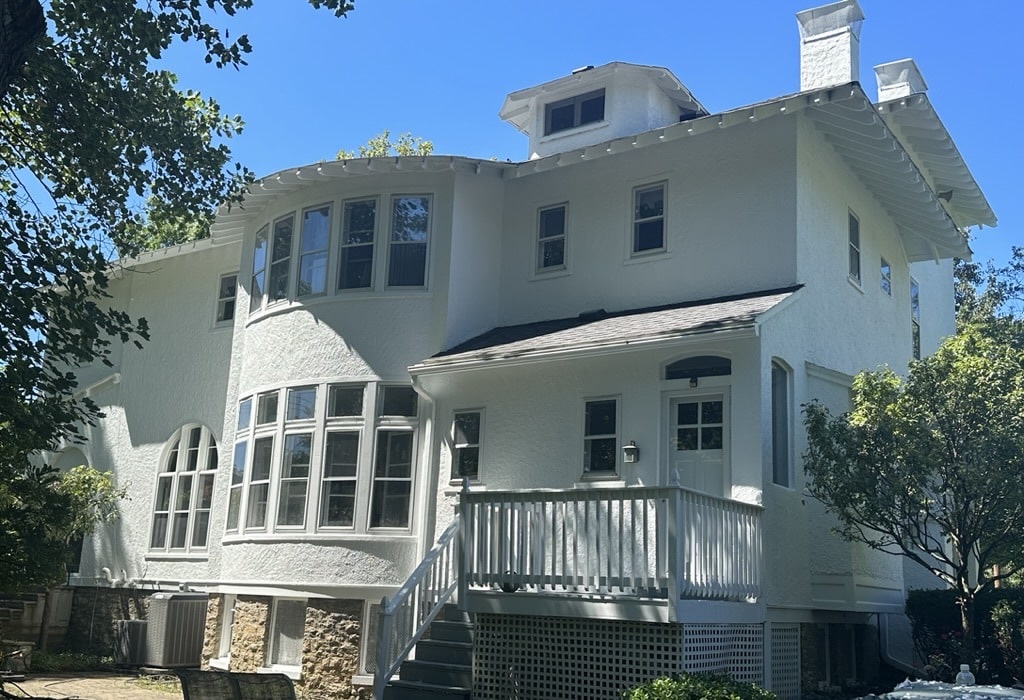If you’re ready to boost your curb appeal, you’ve come to the right place. In this guide, we’ll share expert stucco painting tips that will help you transform your home’s exterior. Whether you want to tackle the job yourself or hire exterior house painters, you’ll find everything you need to know right here.
Key Takeaways:
- Learn the best materials, tools, and paints for stucco.
- Avoid common mistakes homeowners make when painting stucco.
- Get pro advice on surface preparation and paint application.
- Discover color ideas to modernize your home.
- Decide when to DIY and when to hire exterior house painters.

Why Painting Stucco Matters
Stucco is known for its textured beauty and long-lasting durability, but over time it can fade, crack, or look dated. A fresh coat of paint not only protects the surface from the elements but also updates the look of your home.
Step 1: Inspect and Repair Before Painting
Before you start painting, examine the stucco closely for cracks, chips, or damaged areas. Painting over damage will only trap moisture and lead to bigger problems later. Use a patching compound designed for stucco to fill in gaps and allow it to dry completely.
Pro tip: For hairline cracks, use an elastomeric patching material that stretches with the wall to prevent future cracking.
Step 2: Choose the Right Paint for Stucco
Not all paint is created equal when it comes to stucco. You’ll want an exterior acrylic latex paint or an elastomeric paint. Both provide flexibility and breathability, which are important for preventing trapped moisture.
Paint Types to Consider:
- Acrylic Latex Paint: Affordable, easy to apply, and offers great color retention.
- Elastomeric Paint: Thicker and more elastic, ideal for covering small cracks.
Pro tip: If your home gets a lot of sun, choose UV-resistant paint to prevent fading.
Step 3: Prepare the Surface Like a Pro
Preparation is key to a flawless finish. Start by cleaning the stucco with a pressure washer to remove dirt, dust, and loose paint. Let the wall dry for at least 24 hours before priming.
Priming Tips:
- Use a high-quality masonry primer to ensure proper adhesion.
- Apply the primer evenly using a roller designed for textured surfaces.
Step 4: Pick the Perfect Color
The color you choose can completely change your home’s appearance. Neutral shades like warm grays, soft beiges, and crisp whites offer a modern, timeless look. For more personality, consider deep blues or earthy greens.
Color Trends for Modern Homes:
- Warm greige with black trim
- White stucco with wood accents
- Deep charcoal with warm beige trim
Step 5: Apply Paint the Right Way
When applying paint to stucco, use a thick-nap roller or a paint sprayer for even coverage. Work the paint into the textured surface to avoid bare spots.
Application Techniques:
- Apply at least two coats for durability.
- Work in sections to keep a wet edge.
- Avoid painting in direct sunlight to prevent streaks.
Pro tip: Sprayers cover large areas quickly, but follow up with a roller to push paint into crevices.
Step 6: Decide Between DIY or Hiring Pros
Painting stucco yourself can save money, but it’s a labor-intensive job. Professional exterior house painters bring experience, speed, and the right equipment to get it done efficiently.
DIY Pros:
- Lower cost – You’ll save significantly by handling the labor yourself instead of paying for professional services.
- Full control over the process – You decide the pace, the products, and the finishing touches, ensuring the project matches your exact vision.
DIY Cons:
- Time-consuming – Expect to spend several days on preparation, painting, and clean-up if you handle the project yourself.
- Risk of uneven application – Without experience, it’s easy to miss spots or create visible roller and brush marks on the textured surface.
Hiring Pros:
- Quality finish – Professionals have the skills and tools to deliver a smooth, even coat with long-lasting results.
- Faster turnaround – With a trained crew and efficient workflow, the job is completed in a fraction of the time it might take a DIYer.
Hiring Cons:
- Higher cost – Professional services typically come with labor, equipment, and material expenses that add up quickly.
- Less hands-on involvement – You won’t have as much control over the details, as the work is handled entirely by the hired team.
Step 7: Maintain Your Fresh Look
After all your hard work, maintain your painted stucco by cleaning it annually with a gentle hose spray and mild soap. Avoid harsh power washing, which can damage the paint.
Long-Term Maintenance Tips:
- Touch up chips immediately – Small chips or scratches should be sealed quickly to prevent moisture from seeping in and causing bigger problems.
- Repaint every 7-10 years depending on climate – In harsher climates, you may need to repaint sooner to keep the finish looking fresh and protective.
- Inspect for cracks yearly – A quick annual check helps you catch and repair damage before it compromises the paint or stucco.

Frequently Asked Questions About Stucco Painting
How long does painted stucco last?
With proper preparation, the right primer, and high-quality paint, your stucco can maintain its fresh appearance for about 7–10 years before needing another coat, though factors like sun exposure, moisture levels, and local climate can shorten or extend that lifespan.
Can I paint over old paint on stucco?
Yes, as long as the old paint is in good condition and firmly adhered to the stucco surface. Begin by inspecting for any peeling, flaking, or bubbling areas and scrape away all loose paint. After cleaning the surface, apply a high-quality masonry primer to ensure the new coat bonds well and provides a smooth, even finish.
Is it better to spray or roll stucco paint?
Spraying is faster and covers large areas efficiently, making it ideal for big projects or smooth sections of stucco. Rolling, however, pushes paint deep into the textured surface, ensuring even coverage in all the nooks and crannies. Many pros use a combination—spraying for speed, followed by rolling to achieve thorough, long-lasting results.
Final Thoughts
Painting your stucco can transform your home from dated to dazzling. Whether you use these stucco painting tips for a DIY project or to vet potential exterior house painters, the key is preparation, the right materials, and a clear plan. With the right approach, your stucco will look fresh and modern for years to come.
Ready to transform your stucco? Call Queen City Painting and Decorating at 513-643-5050 today for expert service that will make your home stand out on the block.



